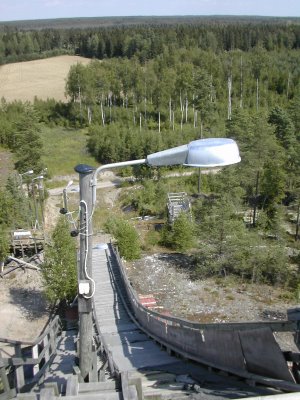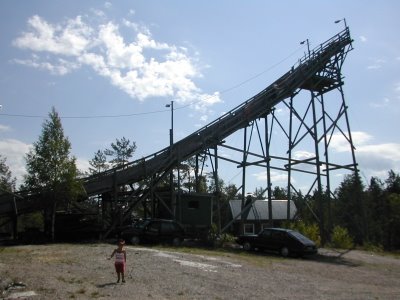Marttila
[Tuesday evening. The email link to Blogger didn't work.]
With the ladies of my family, I'm on the Turku-Stockholm ferry, having spent two days with friends at their summer house in Marttila parish, Finland Proper province, Finland.

The name translates to St Martin's, the patron saint of the parish church. The current wooden structure dates from the 18th century, the first erection on the site took place in 1503, and before that there were small wooden chapels from the 14th century in neighbouring villages. Some clunky wooden sculpture -- including part of a mounted St Martin -- and a baptismal font survive from that time.
Marttila is mostly woodland and fens, what the Finns call erä, or korppi, or salo. A hundred words for boggy evergreen forest... We hiked a few kilometers to a rocky island in a fen, walking on wooden footbridges, picking cloudberries. Beautiful view. Earlier today we went swimming in a disused sand pit and had a look at the spindly skijumping tower that suicidal locals have raised. Two snowmobiles sat under it, waiting for winter.


Marttila village has three great stone memorials. The biggest one is in the churchyard: a collective tombstone for the war dead of WW2. Finnish regiments were organised by village, which gave great troop morale: routing or deserting is out of the question when you fight alongside relatives and neighbours. But this also meant that if a regiment was wiped out, then a village lost an entire generation of men. As did Marttila. The grandfather of our hostess died this way at age 31, leaving a widow and five kids. She later married the farmhand, 15 years her junior, and had another five kids by him.
Another memorial stone marks the place of a battle in 1599 during the Cudgel War under Carolus IX.
The third stone memorial is a bit weird. It was put in place by the Lions' Club in 1974 to commemorate the last beheading in Finland, in 1824. A young man had struck his father so that the man fell and hit his head against the fireplace, dying. The murderer wanted nothing more than to be executed. But what was the intent of the memorial? To celebrate the beheading of a murderer? To celebrate that Finland quit using this particular method of capital punishment very early? Or just to memorialise something Historic taking place in this otherwise fairly anonymous village?
Historic, schmistoric. Our car got really dusty today on the forest tracks, and that's a historic event too in the only meaningful sense, that is, that it actually happened in the past. Dear Reader, please let me know if you erect a memorial to this event.
[More blog entries about travel, Finland, memorials; resa, Finland, minnessten.]
With the ladies of my family, I'm on the Turku-Stockholm ferry, having spent two days with friends at their summer house in Marttila parish, Finland Proper province, Finland.

The name translates to St Martin's, the patron saint of the parish church. The current wooden structure dates from the 18th century, the first erection on the site took place in 1503, and before that there were small wooden chapels from the 14th century in neighbouring villages. Some clunky wooden sculpture -- including part of a mounted St Martin -- and a baptismal font survive from that time.
Marttila is mostly woodland and fens, what the Finns call erä, or korppi, or salo. A hundred words for boggy evergreen forest... We hiked a few kilometers to a rocky island in a fen, walking on wooden footbridges, picking cloudberries. Beautiful view. Earlier today we went swimming in a disused sand pit and had a look at the spindly skijumping tower that suicidal locals have raised. Two snowmobiles sat under it, waiting for winter.


Marttila village has three great stone memorials. The biggest one is in the churchyard: a collective tombstone for the war dead of WW2. Finnish regiments were organised by village, which gave great troop morale: routing or deserting is out of the question when you fight alongside relatives and neighbours. But this also meant that if a regiment was wiped out, then a village lost an entire generation of men. As did Marttila. The grandfather of our hostess died this way at age 31, leaving a widow and five kids. She later married the farmhand, 15 years her junior, and had another five kids by him.
Another memorial stone marks the place of a battle in 1599 during the Cudgel War under Carolus IX.
The third stone memorial is a bit weird. It was put in place by the Lions' Club in 1974 to commemorate the last beheading in Finland, in 1824. A young man had struck his father so that the man fell and hit his head against the fireplace, dying. The murderer wanted nothing more than to be executed. But what was the intent of the memorial? To celebrate the beheading of a murderer? To celebrate that Finland quit using this particular method of capital punishment very early? Or just to memorialise something Historic taking place in this otherwise fairly anonymous village?
Historic, schmistoric. Our car got really dusty today on the forest tracks, and that's a historic event too in the only meaningful sense, that is, that it actually happened in the past. Dear Reader, please let me know if you erect a memorial to this event.
[More blog entries about travel, Finland, memorials; resa, Finland, minnessten.]



2 Comments:
Just a nit: It's "korpi", "korppi" means "raven".
Perkele! Thanks for the correction.
Post a Comment
<< Home